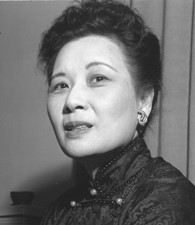Known for her political prowess and powerful husband, Madame Chiang Kai-shek led a somewhat transient life, spending significant portions of her 105 years in Georgia, Shanghai, Taiwan and New York City. Her husband, Chinese Nationalist Chiang Kai-shek, may be more prominent in the history books, but Madame has a fascinating story and fiercely ambitious personality all her own.
Early Days
Madame Chiang Kai-shek was born in Shanghai in 1897 as Mayling Soong. She was the fourth child of six born to Yaoju “Charlie” Soong, a businessman and Methodist minister, and Kwei Twang Nyi, a Christian and “strict disciplinarian,” according to Wellesley College. In 1908, Mayling moved to the United States to be near her sister, a student at Wesleyan College for Women in Macon, Ga. She quickly learned English, spoken with a Georgia accent, and began attending school in Demorset, Georgia.
Mayling followed in her sister’s footsteps, entering Wellesley College in 1913 to study English Literature and philosophy. In 1917, after graduating from Wellesley, she went back to China to refocus on spoken Chinese and Chinese literature, and got involved with social work and child labor issues.
Three years later, she met Chiang Kai-shek, a married Buddhist who was 11 years her elder. Despite his marriage, he proposed to Mayling, and eventually won the blessing of Mayling’s parents after he divorced his first wife and promised to convert to Christianity. According to Wellesley College, he quickly rose in the Chinese military, went on to lead the Nationalist Party and spent the rest of his life struggling against Communist factions.
Sources in this Story
- Wellesley College: Person of the Week: Madame Chiang Kai-shek
- Encyclopedia Britannica: Soong Mei-ling
- Los Angeles Times: Charismatic, Feared Emissary of China’s Nationalist Regime
- The Independent: Madame Chiang Kai-shek
- The New York Times: Madame Chiang Kai-shek, a Power in Husband’s China and Abroad, Dies at 105
Notable Accomplishments
Among many varied achievements, Madame Chiang helped introduce her husband and his anti-Communist, traditional Chinese teachings to the Western world. Later, she worked as a journalist during World War II, composing “articles on China for American journals,” according to Encyclopedia Britannica. During that period, she also became the second woman, and first Chinese woman, to speak before a joint session of the U.S. Congress, during which she asked for more support for her country in the Sino-Japanese War. The trip helped endear her to the American public.
A New York Times obituary of Madame Chiang explains that the Communist victory in China forced her and her husband into exile in Taiwan. After his death in 1975, she moved to New York City for good.
The Woman and Her Work
- “Madame Chiang Kai-shek: China’s Eternal First Lady,” by Laura Tyson Li
- “The Soong Sisters,” by Emily Hahn
- “The Soong Sisters,” directed by Mabel Cheung
The Rest of the Story
Madame Chiang lived to be 105 years old, surviving bouts of cancer, and ultimately succumbing to a flu-like illness on October 23, 2003. She passed away “peacefully in her sleep at her apartment” in a wealthy Manhattan neighborhood where she still socialized with “a small group of loyalists” every year for her birthday.
The Los Angeles Times reported that although she was “revered” and considered by some to be “a shining example of the virtues of an American education,” many others feared her, and saw her as a dictatorial type, “ruthless, corrupt and unmoved by the miseries of the Chinese people.” This attitude was particularly evident in younger generations of Chinese, who considered her anti-democratic.
According to her obituary in The Independent, Madame Chiang once said she’d like to “rule the world” alongside Franklin Delano Roosevelt challenger Wendell Willkie, a man “with whom she had a flirtation.” But writer Christopher Isherwood perhaps best captured Madame Chiang’s formidable personality when he described her as “possessed of an almost terrifying charm and poise.”
This article was originally written by Sarah Amandolare; it was updated January 14, 2017.











